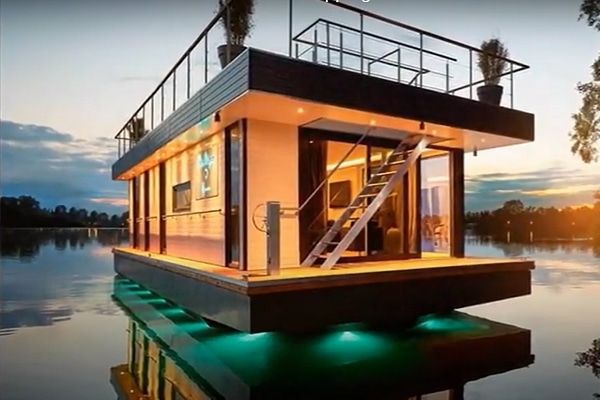- Rent, Lease, or Purchase
- |
March 8, 2022
Shipping Container Houseboat: A Comprehensive Guide


Shipping containers are seaworthy, making them an opportune way to transport tonnes of cargo across continents. Once they are out of service, we can reuse containers to build efficient residential and commercial buildings.
While you might have already seen a shipping container home or a cafe, people are now experimenting with the idea of building floating homes or houseboats using containers.
The idea of living in a houseboat isn’t new. You can find residential floating structures all over the world. If you’ve ever craved a similar experience, investing in a shipping container can bring you one step closer to your dreams.
Below, we’ll take a closer look into what makes shipping containers such excellent options for houseboats and how you can build one for yourself. We'll also look at permits and regulatory requirements, design considerations, and the cost of building a floating home.
What are the Advantages of Living in a Container Houseboat?

The first question you may ask when considering moving off land and onto the water is if it comes with any advantages. The answer, simply put, is yes.
A houseboat provides a safe, comfortable space away from the bustling city life. You don’t have to worry about noise, pollution, and traffic. In most cases, the investment also comes with a pretty spectacular view.
Besides their aesthetic appeal, living in a shipping container houseboat can be a much more cost-efficient alternative to living on land. A breakdown of the average cost of living in your floating shipping container home is as follows:
- Electricity Charges: About $100/month
- Slip Rental: About $300/ month
- Moorage Fee*: About $300/ month
*Moorage fee is the maintenance charge for drinking water supply, waste disposal, marina upkeep, etc. Please note that the prices may vary according to the location, and your municipalities may levy a property tax.
That’s a total of $700 in monthly expenses for your houseboat, much lower than living on land.
Houseboats, Boat Houses, Floating Houses: What's the Difference?

People often use the above terms interchangeably when referring to a floating structure. However, houseboats, boat-houses, and floating houses are not the same. Before we go any further with houseboats, it's important to introduce the difference between these three types of buildings.
Houseboat: Houseboats are homes built on floating platforms. They have a fully-equipped cockpit and a high-speed motor that helps you propel and steer your boat. Generally, we use pontoons as the base structure for building a houseboat.
Living in a houseboat is like being on a 24-hour stay-cation. You can halt the boat at one location if you're staying or travel around in nearby waters without leaving your home. As houseboats are non-permanent, moving buildings like RVs, most municipalities do not levy a property tax on such homes.
Boat House: These floating buildings are similar to a garage where people store their yachts and other marine vehicles. It’s important to note that boathouses are not suitable for people to live in. They can instead be considered a commercial structure.

Floating House: A floating house and a houseboat are pretty similar in their construction. The only difference between the two is that floating houses do not have their own propelling mechanism. You'll need a tug boat or a similar marine vessel to move a floating house.
Most floating houses generally lie stationary at one location, which is why local authorities may impose a property tax on your building.
How to Build a Shipping Container Houseboat
To get started, you’ll need to come up with a plan that includes the floor layout, number of stories, spatial allocations, and accessories. You must also decide beforehand how to manage the utility hookups, property registrations and maintenance, and anchoring. From there, you can follow the steps listed below to begin building your container houseboat.
Select Efficient Barges/Pontoons
Barges and pontoons form the base of your structure. Therefore, you must select a solid foundation that sustains the shipping container's weight without tipping.
You'll need a platform that provides about twice the container's floor space. Next, you must conduct a stability check to ensure that the barge will not overturn at full weight capacity. Consider the weight of the container, utilities, and the number of people at maximum capacity. Include a factor of safety in your design. You should seek professional help if you're unsure of your calculations.
Tip: Add counterweights to your base to balance weight concentration equally on each side.
Procure Containers
Select appropriate shipping containers depending on your floor plan. A 20-foot container will provide about 150 ft2 floor space, while 40-foot units give you about 300 ft2 carpet area. Contact a container specialist for help finding the right container for your needs.
You can also read our size guide to learn more about shipping container dimensions.
Fabricate Your Containers

Mark where you want to cut doors, windows, and skylight openings. Use a metal grinder or a flame cutter to create the openings. Install the windows and the doors at their specific positions.
Next, you must determine the utility plug points such as electric sockets, taps, and ventilation. Once you finalize the lining, you must add insulation to your container. Insulation can help you conceal wires and pipes and help maintain the ideal temperature. These modifications will help make the container livable in a shorter amount of time.
Add Furniture and Accessories
Set up a kitchen table or add a sleeper sofa to your living room. The house is yours to design. You can also put a mini-fridge, gas stove, chairs, wardrobes, and bookshelves to make your shipping container more comfortable and livable.
Watch this video for a better view of the process.
Important Considerations for Building a Shipping Container Houseboat
Building a floating container house can be a pretty tedious process. That’s why you need to start planning and procure all materials beforehand. Listed below are a few tips that can help ensure things run smoothly.
Selecting a Location
When scouting locations for your houseboat, select a waterbody with good connectivity. Also, ensure that the area does not experience turbulent waves. Lastly, do not park your houseboat in a wildlife area or an eco-sensitive zones. Build your home near the launch location so that you can quickly transport the structure to the barge.
Number of Stories

You can decide between a single-tier house or a multi-tier structure. A multi-story home provides additional space in the form of reading rooms, bedrooms, and dining areas for more functional living quarters.
You can also create more storage space or a roof deck by stacking two shipping containers on top of one another.
Space Considerations
You'll need adequate room for your bedroom, living area, and utilities. Besides the container size, the way in which it’s organized can make all the difference. For instance, placing four containers in a square shape can give you additional space plus a courtyard garden in the middle.
Materials and Accessories
You'll need wooden bars, steel plates, and fixtures for making an insulated container. Similarly, you'll have to measure the distance between electric and plumbing outlets to find how much wiring and plumbing you'll need. Depending on your electricity requirements, you'll need panels, switches, and electric equipment.
Sewage and Toilet Water
You'll need either a compost toilet or a marine flush toilet to manage wastewater on your floating shipping container home.
A compost toilet is a self-contained system that helps you break down solid waste without any odor. If you have adequate space for a flush tank, you can select a marine flush toilet instead. These blocks have a built-in device that prevents water from spilling out of the bowl.
You can store the black water in a sewage tank outside the main building. Whenever you park your boat at a marina, you can discharge the stored toilet water with a pump.
Electricity

You can secure electricity for your shipping containers in three ways:
- Using an electric hookup to source electric current from a boatyard or marina.
- Diesel generators connected with a storage battery
- Solar panels
Leakages
Make sure that there are no holes or leakages in your container so that it does not compromise the structural integrity of your home. A leaky shipping container can also affect the barge's stability.
Are shipping containers watertight?
Shipping containers have wind and watertight structure that helps them float even at full capacity. However, structures must remain watertight in order to float. Any leakage in your container can disrupt the stability.
Cost of Building a Houseboat
The total cost of building a floating shipping container home will depend on the number of containers you use, modifications, accessories, docking charges, utilities, and taxes.
A single container unit can cost anywhere between $2,500-$8,000 plus delivery charges. You'll also need an additional $20,000 -$25,000 to pay for the barge.
Combining all the expenses, we estimate the total cost of a floating shipping container house to be about $75,000-$90,000.
What Codes are Enforced With Building a Houseboat?

While the building codes can change according to local guidelines, some general guidelines remain the same. For instance, your local authority may enforce the 'Moorages and Floating Structures Code (MAFSC)' on your building to ensure that you're complying with building regulations. MAFSC includes the location, construction, use, and occupancy requirements of floating structures.
Ensure that you secure a construction permit beforehand. Before issuing the green light, officials may inspect your design to ensure that you're meeting the building codes and regulatory guidelines.
General practices you must follow during construction to experience success during these inspections include:
- Build a safe structure with proper exit paths and safety accessories.
- Ensure that there's a walkway on all sides of your house.
- Include smoke detectors, fire extinguishers as per building codes.
- Check if there's proper airflow and ventilation. If you're using HVAC units, create an appropriate maintenance plan.
- Ground electric sources and add fault interrupters to avoid risks of shock.
- Select the correct pipe sizes and connections.
- Create proper outlets to drain sewage water.
Federal guidelines like the EPA regulations and rules enforced by the Coast Guard apply to marine vessels. The Coast Guard regulates the building, manufacturing, fuel systems, floatation, and loading of houseboats. The EPA issues rules for sewage management and waste handling for keeping water bodies safe.
Conclusion
The versatile construction of a shipping container can help you build efficient houseboats and floating homes. Before building your floating home, ensure that you're following the building codes and regulatory guidelines. Sourcing your shipping container from a reputed supplier can help you avoid leaky and low-quality structures for your houseboat.
Mobile Modular Portable Storage provides high-quality shipping containers for rent and sale at affordable prices. Call us at 866-459-7600 or request a quote to learn more about our industry-specific container solutions.
Frequently Asked Questions
Are There Any Houseboats Built from Shipping Containers?
There are many shipping container houseboats around the world. For instance, Denmark and the Netherlands have floating student apartments built from Conex boxes. In the United States, the 1000-foot shipping container houseboat at Maine received widespread popularity for its innovative design.
How Much Does It Cost to Build a Shipping Container House?
You can build a floating shipping container house for about $75,000-$90,000. The total cost of your house will depend on the number of containers, utilities, modifications, and accessories.
How Long Do Container Homes Last?
Shipping containers have a high-strength Corten steel body, making them highly durable. A home built from shipping containers can easily last for about 15-20 years.
Related Blogs



Subscribe to Our Blog
Enter your email address to subscribe to the blog and receive the notification of new posts by email.
Thank You for Subscribing to Our Blog!
Stay tuned for upcoming emails with valuable content that we hope will enhance your experience with our brand.
Both Pardot and mg360 form submissions failed.
